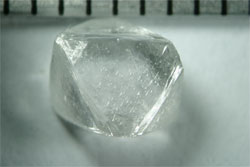Research Highlights 2007
 |
 |
 |
 |
TerraneChron®
TerraneChron® is GEMOC’s unique methodology for terrane evaluation. During 2007 collaboative research projects with industry using TerraneChron® yielded a wealth of information to map crustal history on different scales.
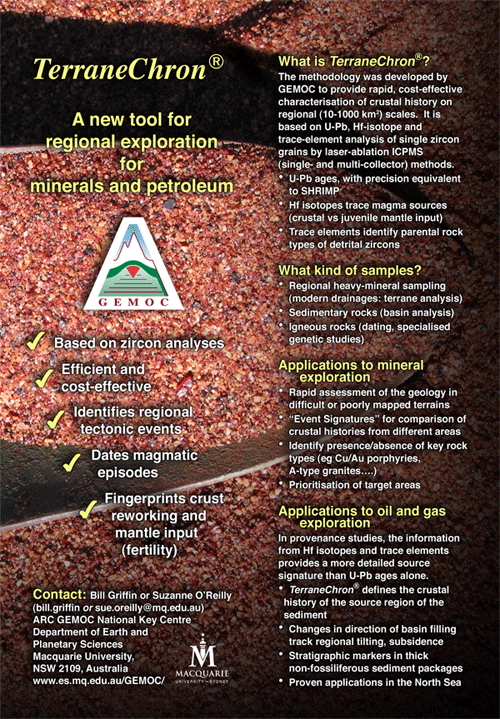
Where on/in Earth are Diamonds? (Diamond, subcalcic garnet and mantle metasomatism)
Kimberlites are the major source of natural diamonds, but fewer than 1% of kimberlites contain economic quantities of diamond. Even within a single kimberlite field, economic and barren kimberlites may occur within very short distance of one another, and it is rarely obvious what has controlled the small-scale distribution of diamond in the mantle volumes sampled by different kimberlites. However, a spinoff observation arising from GEMOC’s ongoing 4-D Lithosphere Mapping project may have provided an important clue (GEMOC Publication #449).
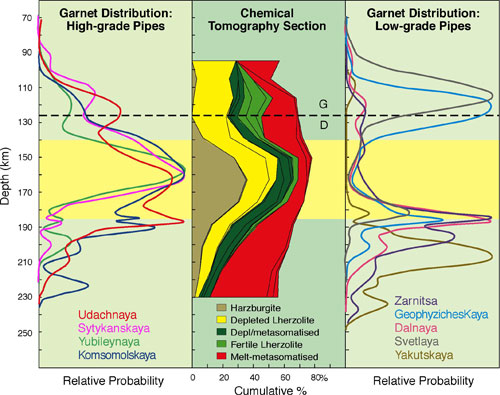
Figure 1. Chemical tomography section for Daldyn kimberlite field (9 kimberlites, 858 garnets), showing relative abundance at each depth of garnets from harzburgites, depleted lherzolites, depleted but metasomatised lherzolites, fertile lherzolites (also interpreted as metasomatic products) and lherzolites metasomatised by silicate melts. The strong concentration of harzburgitic garnets in 140–180 km depth range is marked by a shaded horizontal band. Curves show distribution of sampling depths of garnet grains entrained in high-grade (left) and low-grade (right) kimberlites from Daldyn field and adjacent Alakit field. Horizontal dashed line is graphite (G)- diamond (D) phase transition.
The heavy mineral concentrates of kimberlites typically contain xenocrysts of both peridotitic garnet and chromite, derived by disaggregation of the mantle wall rocks sampled by the kimberlite. The Ni content of the garnets, and the Zn content of the chromites, can be used to measure their temperature of equilibration, and these temperatures can be translated to depth estimates for each grain, by reference to a local geotherm derived either from the garnet populations or from peridotite xenoliths. With this information, we can draw curves showing where the kimberlite picked up its load of garnet and chromite during ascent to the surface.
In the Daldyn and Alakit kimberlite fields of Siberia, strongly depleted harzburgitic rocks are largely confined to a narrow depth range of 140-190 km, whereas less depleted lherzolites dominate the mantle section above and below the harzburgitic band. Numerous studies of diamond-bearing xenoliths and mineral inclusions in diamonds from these two fields show that the vast majority of the diamonds in the pipes come from the harzburgitic band. Depth-distribution curves of garnet from these two fields (Fig. 1) show that most of the garnets in the pipes with high diamond grade come from the harzburgite-rich level, whereas the low-grade pipes contain lherzolitic garnets from deeper and shallower depth, but few grains from 140-190 km depth. Similar patterns have been found in the Archangelsk kimberlite province of NW Russia.
Figure 2. Temperature (depth) distribution of garnets and chromites in high- and low-grade kimberlites. A: Daldyn field, high-grade Udachnaya pipe and low-grade Zarnitsa pipe. B: Arkhangelsk field, high-grade Lomonosovskaya pipe and low-grade Solokha pipe. Shaded band shows temperature range of the depleted harzburgite-rich layer beneath each field (cf. Fig. 1).
The distribution of chromite is quite different -- it peaks in the harzburgitic layer in both the high-grade and the low-grade pipes (Fig. 2). It appears that (1) all of the kimberlites have sampled the harzburgite-rich layer; (2) chromite is ubiquitous through the layer; (3) diamond and garnet occur together, but only locally, within the layer. This suggests a genetic relationship, in which the metasomatic processes that deposit diamond also are responsible for depositing garnet. Another key observation is that chromite xenocrysts in barren kimberlites typically are more oxidised (with higher mean Fe3+/Fe2+) than those from high-grade pipes, and chromites included in diamond generally have very low Fe3+/Fe2+ (Fig. 3). These observations suggest that diamond and harzburgitic garnet are linked to the same metasomatic process, through generalised reactions of the type: CH4 (in fluid) + Fe3+(in chromite) + Si, Ca, Mg (in opx, fluid) → diamond + garnet + H2O +Fe2+(in chromite).
We suggest that where melts or fluids derived from below the depleted lithospheric mantle first penetrate the harzburgitic layer along fractures, CH4-rich fluids derived from them react with the wall rocks, producing subcalcic garnet, diamond and a reduced diamond-bearing harzburgite. As the melts themselves penetrate into the lithosphere, metasomatism adds more Ca, Al and Fe, refertilising the harzburgite to produce lherzolites. Oxidation during this metasomatism would tend to destroy diamonds, producing a positive correlation between harzburgitic minerals and diamond, and a negative correlation between lherzolitic minerals and diamond, as observed in many kimberlite fields. Volumes of the harzburgitic layer that were never metasomatised would contain neither diamond nor garnet.
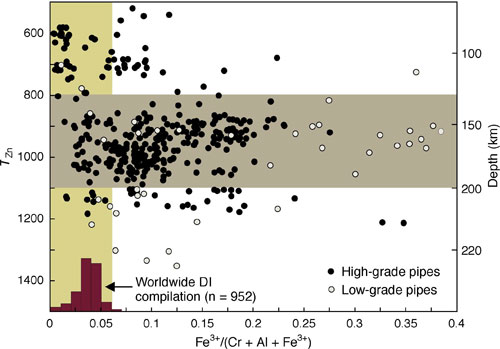
Figure 3. Fe3+/(Cr + Al + Fe3+) of chromites vs depth in kimberlites from the Arkhangelsk field. Box shows range of values in diamond inclusions (DI) worldwide; horizontal band shows depth distribution of harzburgitic rocks.
These processes could operate on the scale of individual melt conduits, producing very small-scale variations in diamond content within the lithosphere. The diamond grade of later kimberlites would be dependent on their path through this heterogeneous mantle (Fig. 4). Kimberlites following old conduits that experienced mainly the first stages of the metasomatism could have high grades; those that sampled unmetasomatised volumes would be barren; those that followed well-worn magma conduits, now lined by lherzolite, might contain diamonds, but at lower grades.
This picture of the mantle suggests that it might be possible to analyse the distribution of high-grade and low-grade pipes within a single kimberlite province to map out the positions of the best structures at depth, and to target detailed brown-field exploration efforts.
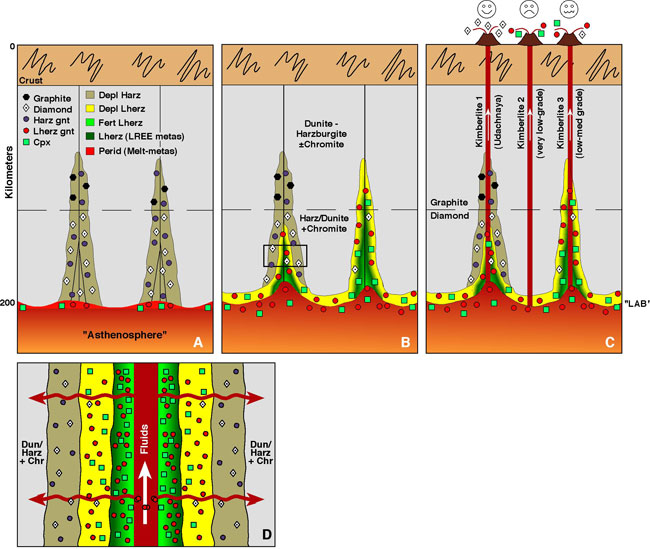
Figure 4. Evolution of the subcontinental lithospheric mantle (SCLM) beneath the Daldyn-Alakit area. A: Primitive Archean SCLM, consisting of relatively oxidised harzburgite/dunite, is metasomatised by Si-bearing CH4-rich fluids brought in low-degree melts from the underlying “asthenosphere”; precipitation of diamond/graphite ± harzburgitic garnet near fluid conduits. Melt-related metasomatism near lithosphere-asthenosphere boundary (LAB) converts some harzburgites to fertile lherzolite by addition of Ca, Fe, Al. B: Continued input of melts/fluids; reduced harzburgite does not precipitate diamond/graphite; melt-related metasomatism refertilises harzburgite to lherzolite at base of lithosphere and along conduits (weakly in left conduit, more extensively in right conduit); relict harzburgitic diamonds in lherzolites. C: Kimberlite eruption (Devonian); high-grade pipes sample remnants of Stage-A modified mantle. Barren pipes sample least-metasomatised mantle and lack harzburgitic garnets and diamonds; some low-grade pipes sample highly metasomatised mantle with relict diamonds. D: Detail of melt conduit showing progressive metasomatism of wall rocks, first by CH4-rich fluids expelled from melts, and then by the melts themselves. Abbreviations: Dun—dunite; Harz—harzburgite; Lherz—lherzolite.
Contacts: Vlad Malkovets, Bill Griffin, Sue O’Reilly
Funded by: MURF, MUNS, ARC Discovery
Chemical impurities in gem-quality diamonds
| The study of diamonds is a very attractive topic since they can reveal unique information from the Earth’s mantle. A comprehensive study of diamonds includes both simple and advanced methods as morphologic description, cathodoluminescence imagery, vibrational spectroscopy and stable isotope analyses. Recently, a methodology developed at GEMOC using LA-ICPMS (Laser Ablation Inductively Coupled Plasma Mass Spectrometry) has made it possible to investigate the very low levels of chemical impurities found in micro-inclusions within the diamonds. The technique consists of ablating the diamond surface with a laser beam, which drills a hole approximately 50 µm deep over about 2 minutes. The result is a time/space-resolved signal that reveals the chemical composition of the diamond across the depth analysed. These chemical impurities are interpreted as the composition of the fluids that once deposited that diamond in the mantle.
In our current research, the LA-ICPMS technique meets a simple and traditional method of studying diamonds: their morphology and surface textures. Diamonds are formed as octahedral and cubic crystals. Despite their well-known hardness, certain conditions (high oxygen fugacity) can corrode the surface of diamonds, forming a variety of corrosion figures, or etching pits. This dissolution can happen during the diamond’s residence in the mantle and/or in the magma during its ascent to the Earth’s surface. In octahedral diamonds, one of the most common corrosion figures is the trigon. These are triangular pits, either point- or flat-bottomed. The point-bottomed ones are formed at the end of crystal defects, where dislocation lines emerge from the centre of the diamond. The flat-bottomed trigons have been related to clusters of chemical impurities or crystal defects. For the first time we could test this hypothesis using LA-ICPMS. |
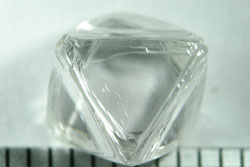
Figure 1. White octahedral diamond with smooth surface. Figure 2. White octahedral diamond with rough surface covered with trigons, scale divisions = 1 mm. |
In our investigation, we analysed gem-quality octahedral diamonds from Canada. Most of them have smooth surfaces (Fig. 1) but some have abundant flat-bottomed trigons (Fig. 2) covering some or all the surfaces. Using LA-ICPMS, we found that abundant flat-bottomed trigons occur only where a sub-surface layer is enriched with various trace elements, as Ca, Mg, Fe, K, Ba, Sr, LREE, among others. The surfaces with trigons were examined in the microscope (Fig. 3), and micro-inclusions were found distributed in a thin layer 15-20 microns beneath the surface, corresponding to depth of the flat bottoms of the trigons. The micro-inclusions are rounded and small single fractures, which can be both crystallographically [111] and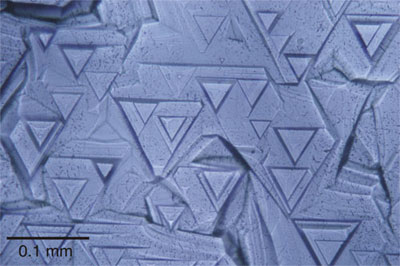 randomly oriented, extend from them, producing a tadpole-like shape (Fig. 3). Such inclusions are absent beneath faces that lack trigons. The chemical composition of the micro-inclusions is similar those of carbonatitic fluids, suggesting that fluids of this composition were able to wet some surfaces of the growing diamonds, before becoming trapped beneath a new layer of “clean” diamond. The role of such mantle fluids in the formation of diamonds is a key direction for further research.
randomly oriented, extend from them, producing a tadpole-like shape (Fig. 3). Such inclusions are absent beneath faces that lack trigons. The chemical composition of the micro-inclusions is similar those of carbonatitic fluids, suggesting that fluids of this composition were able to wet some surfaces of the growing diamonds, before becoming trapped beneath a new layer of “clean” diamond. The role of such mantle fluids in the formation of diamonds is a key direction for further research.
Contacts: Debora Araujo, Bill Griffin, Sue O’Reilly, Norman Pearson
Funded by: ARC Linkage, Macquarie University and Rio Tinto
Figure 3. Surface with trigons and micro-inclusions at 15 µm beneath the diamond surface.
Core-mantle boundary interactions: The deep mantle goes with the flow
Our understanding of the earth’s core-mantle boundary (CMB) region has improved significantly over the past several years, due in part to the discovery of the “post-perovskite phase”, a polymorphic transition in the deepest levels of the mantle. The post-perovskite mineral phase is known through experiment and theoretical calculations to be stable in the lowermost ~150 km of the mantle (the D" layer). Seismic data suggest that the CMB region is highly heterogeneous; this heterogeneity may be partly due to the structure of the post-perovskite phase, and may also reflect chemical and physical interaction between outer core liquid and the lowermost mantle. In 2007, we proposed a new mechanism of mass transfer across the CMB and suggested possible repercussions that include the initiation of deep, siderophile-element-enriched mantle plumes. We view the nature of core-mantle interaction, and the geodynamic and geochemical ramifications, as multiscale processes, both spatially and temporally (Fig. 1). On the microscale (1-50 km), the effect of loading and subsequent shearing of the CMB region where cold downwellings impinge on the outer core can drive local flow of the outer core fluid upwards into the D" layer. This process can be linked to the larger-scale processes operating on the mesoscale (50-300 km) and macroscale regimes (> 300 km). As Fe-rich liquids from the outer core infiltrate into the D" layer, they will interact with the silicates and enrich them in Fe. These processes may also impact on global mantle dynamics. Reacting Fe-rich post-perovskite material may be partially responsible for ultra-low-velocity zones (ULVZ: Fig. 1), which are zones in the D" region where silicate melt is present, and will influence the nature of thermal conduction across the CMB. Infiltration of outer-core liquids into D" also provides a mechanism for imparting a distinctive HSE chemical signature to the lowermost mantle, from where it can be transferred to plumes and the minerals enclosed in some lower-mantle diamonds (see GEMOC publication #229). Infiltration of core-derived fluids into the lower mantle requires shear-induced dilatancy to allow fluid movements; encouragingly, there is some new experimental evidence in support of the dilatant mechanism at elevated PT conditions.

Figure 1. Summary diagram showing the proposed relationship between each of the three key length scales described above.
Contacts: Tracy Rushmer, N. Petford (Bournemouth University), David Yuen (University of Minnesota)
Funded by: MQNS and NASA
Core formation, crystallisation of the mantle and oxidation of the Earth
The earth appears to have grown from smaller asteroidal bodies over a period of about 40 million years after the beginning of the solar system, 4567 million years ago (see Research Highlight 2006). Research at Macquarie is concentrating on understanding the timing and processes by which the Earth segregated its metallic core and the crust began to form from the silicate mantle. The way in which the research is done is by experimentally simulating the high pressure, high temperature conditions of, for example, metal separation and determining the partitioning of suites of important chemical elements between the metal and silicate liquids. Then, by comparing the compositions of the silicate parts of the experiment to that of the silicate part of the Earth, we can start to place constraints on how core formation occurred.

Figure 1. Changes in partition coefficients for different elements, as the Earth grew. Note the apparent increase in the oxidised-iron content of the mantle during this process.
An important requirement is a reference point for the composition of the bulk Earth. This is provided by the primitive meteorites which are chemically similar to the Sun and which have striking affinities with the Earth, Mars and the Moon (see Research Highlight 2006). Taking these meteorites as representatives of protoplanetary material we find that the silicate part of Earth is depleted in refractory “siderophile” elements (Fe, Ni, W, etc) because of extraction to the core but undepleted in refractory “lithophile” elements which remain in the mantle. By mass-balance we can calculate the partitioning of the siderophile elements between the core and the silicate mantle and compare the results to our experiments. The results indicate that the Earth must have started out very reduced and then become more oxidised as it grew. This is the only way we can match the core-mantle partitioning of all the well-studied elements. Figure 1 shows a typical oxidation path which correctly reproduces the core-mantle partitioning of a large number of elements. Progressive oxidation, as represented by the weight % of oxidised iron in the mantle is modeled, for simplicity in 2 steps, but in reality was probably continuous.
If the Earth became oxidised as it grew, the important questions are: (a) how did it happen? and (b) what are the implications? The answer to the first question is that there are several possible mechanisms which call on outside influences (accretion of oxidised material, for example) and are hence unconstrained. Recent discoveries demonstrate, however, that there is a mechanism by which the Earth self-oxidised. This arises from the observation that silicate perovskite, the mineral which is stable throughout the Earth’s lower mantle, has a very strong affinity for ferric iron, Fe3+. We now know that this affinity is so strong that it forces Fe2+ to disproportionate to form Fe3+ and metallic iron:
3Fe2+ = 2Fe3+ + Fe0(metal)
Perovskite started to become stable in the Earth’s interior when the planet reached 10% of its current size (about the size of Mars). Thereafter, segregation of metal to the core combined with continuous impact of accreting bodies “pumped-up” the Fe3+ content of the mantle. This occurred by continuous dissolution and reprecipitation of perovskite in the lower mantle (see Fig. 2).
content of the mantle. This occurred by continuous dissolution and reprecipitation of perovskite in the lower mantle (see Fig. 2).
The important point about Earth’s self-oxidation is that it was caused internally rather than by, for example, subduction of oxidised material after the rise of atmospheric oxygen. This explains why all measurements of the oxidation states of materials from the mantle indicate no change since the Archean and no effect of the rise of atmospheric oxygen. The process took place earlier and was internal (see GEMOC Publication #513).
Contact: Bernard Wood
Funded by: Federation Fellowship, ARC Discovery, Macquarie University
Figure 2. Cartoon illustrating the convective dissolution and reprecipitation of the high-pressure perovskite phase. As the Pv sequesters Fe3+ native iron (melt) is formed and sinks into the core.
Nickel Sulfide Deposits – Developing New Exploration Tools
large proportion of the world’s nickel production comes from deposits of Fe-Ni-Cu sulphides within mafic/ultramafic intrusions and flows, e.g. komatiites and komatiitic dunite bodies. The Norseman-Wiluna Greenstone Belt (NWGB), Yilgarn craton (Western Australia), is one of the world’s major nickel provinces, containing over ten million tons of nickel metal, and hosts two of the world’s largest komatiite/komatiitic dunite-hosted Ni-Cu-(platinum-group element: PGE) deposits. Since the first nickel boom in the 1970s exploration for more world-class deposits has continued – but the complex deformation and metamorphism of the NWGB make it difficult to understand the stratigraphic relationships and the processes responsible for Ni-Cu-(PGE) ore localisation.
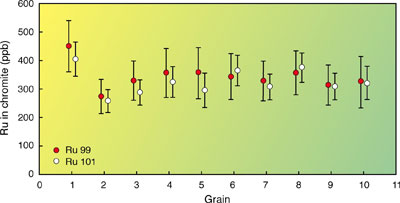
Figure 1. Ruthenium concentration in komatiitic chromite, calculated from the isotopes 99Ru and 101Ru. Each number represents one analysed grain. Constant Ru concentrations on the sample scale indicate that Ru occurs in solid solution, as micro-inclusions would cause scattered patterns.
A long-standing goal of research on komatiite-associated nickel-sulfide (NiS) deposits has been the development of lithogeochemical indicators that can guide exploration. Such indicators have two purposes: 1) to discriminate mineralised from barren komatiite belts, and 2) to identify vectors towards sulphide ores within mineralised sequences. Lithogeochemistry of komatiites is currently applied in NiS exploration in two distinct ways: indirectly, through identification of favourable geological environments, and more directly, through identification of signatures that record sulphide liquid segregation.
The AMIRA P710A project was established to find out if the PGE distribution in mafic and ultramafic systems is related to NiS mineralisation, and to test the applicability and usefulness of PGE lithogeochemistry in the discrimination of barren and mineralised units. The project is a co-operation between GEMOC, the Centre for Exploration Targeting (CET) of the University of Western Australia and CSIRO Exploration and Mining, and is funded by BHP Billiton, Norilsk Nickel, Independence, and Meriwa.
GEMOC’s contribution to this project builds on its expertise in understanding the behaviour of PGE in the mantle and its world-class micro-analytical facilities. We are investigating mechanisms of PGE fractionation in mafic and ultramafic melts, to identify PGE signatures in oxides and silicates from S-undersaturated systems and develop vectors towards the sulphur-saturated part of a system, where NiS mineralisation might occur. The study started with komatiites, representing the most primitive magmas, and will move to more fractionated magma types, such as komatiitic basalts, ferropicrites and dolerites.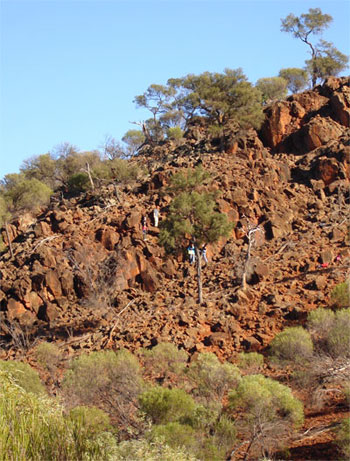
The generally accepted model for NiS ore-formation in komatiitic systems requires the interaction of a sulphide liquid with a silicate melt. As PGE (Os, Ir, Ru, Rh, Pt, Pd) partition very strongly into sulphides, the remaining silicate melt will be depleted in PGE. A depleted whole-rock PGE signature might reflect interaction with a sulphide liquid, and the degree of depletion might increase towards NiS mineralisation. However, the PGE contents of melts reflect many factors, including parental magma composition, initial sulphur content, oxygen fugacity and wall-rock contamination, so a PGE-depleted signature may not necessarily reflect segregation of sulphides. Therefore, all lithogeochemical vectors currently used in exploration for komatiite-hosted NiS deposits provide inconclusive and contradictory results. Rather than using absolute levels of PGE, sulphide segregation might be recognised by using correlations of the PGE with elements that record the evolution of the magmatic system. Instead of interpreting whole-rock signatures, this study will directly use PGE signatures in primary magmatic phases (e.g. chromite and olivine) to determine if a system equilibrated with sulphides and formed a NiS deposit.
Komatiitic flow field in the Norseman-Wiluna Greenstone Belt near Kambalda (Yilgarn Craton, Western Australia).
For this purpose, a method for the in situ analysis of Ru in chromite by Laser Ablation ICP-MS is being developed to provide the industry with a fast but precise analytical technique in the exploration for NiS deposits. The initial results show the first convincing evidence that Ru exists as solid solution in komatiitic chromite (Figs. 1 and 2) – and suggest we can recognise chromites from barren and mineralised sequences using the Ru concentrations in chromite.
Contacts: Marek Locmelis, Norman Pearson, Suzanne O’Reilly, Marco Fiorentini
Funded by: Macquarie University iMURS, ARC Linkage, Industry
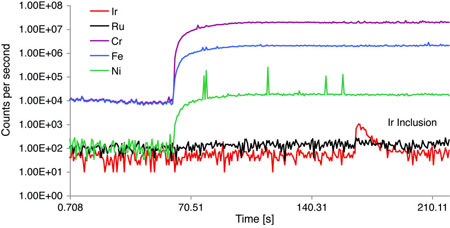
Figure 2. Time-resolved signals for several elements in a chromite from a komatiitic basalt, during a LAM-ICPMS analysis. An easily detectable Ir micro-inclusion less than 1 µm in diameter (black line) does not affect Ru abundance (red line), indicating that Ru is in solid solution in the chromite.
Crust-mantle evolution in NW Spitsbergen: Re-Os, U-Pb and Hf isotope data
Spitsbergen, the largest island of the Svalbard Archipelago, is located in the northern Arctic Ocean. The Svalbard archipelago lies near the north-west margin of the Eurasian plate and represents an uplifted part of the submerged Barents Shelf. The NW tip of Spitsbergen is fertile ground for studying the evolution of the uppermost mantle and continental crust during continental breakup. The exposed crustal rocks are metamorphosed igneous rocks of the NeoProterozoic to Caledonian Hekla Hoek Group. Xenoliths derived from the mantle and lower crustal are abundant in Holocene basaltic flows and pyroclastics that make up the Bockfjord Volcanic Complex. In situ isotopic techniques have been used to date thermal events in the upper crust (zircons from glacial streams), lower crust (zircons in granulite xenoliths) and upper mantle (sulfide inclusions in mantle xenoliths).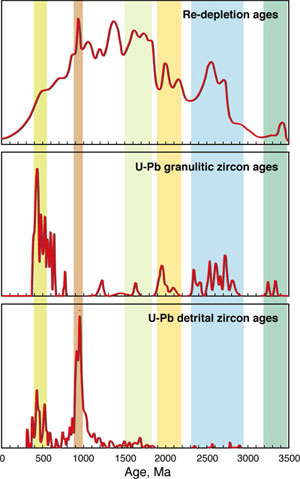
Figure 1. Thermal events recorded in sub-continental lithospheric mantle, lower upper continental crust under NW Spitsbergen, revealed from in situ Re-Os, U-Pb and Hf isotope data.
In situ U-Pb and Hf-isotope analysis have been performed on detrital zircon grains collected from outwash streams of the Adolfbreen Glacier, which drain a large area of outcropping Hekla Hoek formation. The most significant age population is Grenvillian (ca 0.94 Ga), and the Paleozoic component is surprisingly small, considering that Svalbard was affected by the Caledonian Orogeny (ca 0.41-0.32 Ga) with a climax in Silurian time. There are some scattered mid-Proterozoic ages, and a few grains with Archean ages (ca 2.9-2.3 Ga). On the age data alone, we could suppose that the crust is relatively young. However, the Hf isotope compositions of the zircons (Fig. 2) show that the Grenville and Caledonian zircons crystallised from magmas that were derived largely from much older crust – ranging from Mid-Protoerozoic to Archean.
Zircon grains separated from the lower-crustal granulite xenoliths give an even more surprising story. There is a large Paleozoic population, but the Grenvillian population that is so prominent in the upper crust is absent. Instead, there are important populations in the Paleo-Proterozoic (2.0-2.5 Ga) and Archean (most 2.5-3.0 Ga, extending back to ca 3.3 Ga). The Hf isotopes indicate that juvenile crust was formed mainly in Archean time, whereas the Paleozoic magmatic event involved mixing between juvenile mantle-derived magmas and the ancient lower crust. The prominence of mafic lithologies suggests that basaltic magmas underplated the crust before and during the Caledonian orogeny.
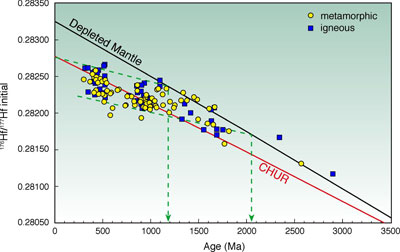
Figure 2. Hf-isotope data plotted against age, for zircons from Bockfjord. Sample taken in the outwash from Adolfbreen Glacier.
In situ Re-Os analyses of sulfides in mantle-derived peridotite xenoliths give model ages ranging Early- Mid-Archean (ca 3.4 Ga) to Paleozoic (ca 0.4 Ga) (Fig. 1). The oldest sulfide populations (ca 3.4-3.3 Ga and 2.8-2.4 Ga) are preserved in the most depleted peridotites and are interpreted as minimum ages for the oldest melt-depletion events. They match the prominent older population of zircon ages in the lower-crustal xenoliths. Another sulfide population between ca 1.8-2.3 Ga has some equivalents in the zircon data from the lower crust, but upper- crustal ages in this range are rare. The sulfide populations between ca 1.8-1.3 Ga have few matches in the crustal ages from zircons, and may represent mixing between younger and older sulfide generations. One significant age population (TMA model age ca 0.94 Ga) correlates with the major Grenvillian crustal tectonic event seen in the zircon data (Fig. 1). The youngest sulfide population (TRD model age ca 0.52 Ga) may represent refertilisation of the lithospheric mantle by metasomatic fluids introduced in pre-Caledonian time.
The correlation between major mantle events recorded in the sulfide populations, and thermal events recorded by magmatic zircons, suggest that several of these tectonic events, involving magmatism and reworking of older crust, affected the whole lithospheric column in this region from at least the Early/Mid-Archean to the Caledonian time (Fig. 1). While the Grenvillean and Caledonian events have effectively reworked the upper crust, the Hf-isotope data, and the ages from the lower crust and mantle, show that the older lower crust and its underlying mantle lithosphere were preserved through these major orogenies. 
The view from Bockfjord: Sverefjell volcano to the left, the crags of the Hekla Hoek gneisses in the distance, and Adolfbreen Glacier pushing down to the sea.
Contacts: Nenad Nikolic, Suzanne O’Reilly, Bill Griffin
Funded by: iMURS, ARC Discovery (O’Reilly, Griffin et al.), EPS and MQ postgraduate grants
Extreme plate tectonics
Why does plate tectonics occur on Earth and not on other terrestrial planets? How long has Earth had plate tectonics? Would exosolar super-sized Earths around other stars have plate tectonics?
These questions were the impetus for work completed at GEMOC this year exploring the conditions for plate tectonics through numerical simulations (see GEMOC publication #497). To understand plate tectonics, we must understand the coupling between the convecting mantle and rheologically complex tectonic plates. If the driving stresses generated by the engine powering plate tectonics - mantle convection - are larger than the resistive strength of the plate, then the tectonic plate can fail, a crucial requirement for functional plate tectonics. If not, then the planet’s lid will remain stagnant, much like the surface of Mars or Venus today.
The studies used a combination of scaling arguments and numerical models to explore the transition of systems from stagnant-lid into active-lid (ie. plate tectonic) modes. We found that a critical factor is the depth to the brittle-ductile transition (BDT); along with the frictional strength of the lid, this determines the resistance of the lid to convection. The BDT is related to the thickness of the elastic lithospheric, which is a known quantity on most terrestrial planets and moons. This allowed a test of the theory against a spectrum of observed bodies in the solar system. Earth itself plots clearly on the plate tectonic side of the transition - a function of its powerful internal engine and water-weakened plates. Mercury, the Moon and Mars all have lithospheres that are too thick for their feeble mantles to budge. Mars may have been active in the distant past, but only if the surface was altered by liquid water. Venus lies close to the transition, consistent with suggestions it is in an episodic mode - oscillating between active and stagnant lid tectonics. Interestingly, Io and Europa also lie close to the transition. Rugged, tilted mountain ranges on Io and non-tidal ice cracking and evidence of a lithosphere on Europa both hint that these moons of Jupiter may experience more surface tectonism than previously thought.

Figure 1. Simulations show that when pushed to extremes - either through heat, size or lithospheric strength - plate tectonics can break down and mantle convection enters a regime known as episodic overturn, where long periods of quiescence are interspersed with rapid subduction events, accompanied by large pulses of mantle melting and plate velocity. 1-3 shows snapshots of such an event (sowing temperature field and mantle melting). Earth may have been in such a regime in its early history due to the extreme thermal regime.
How different might plate tectonics have been on the early Earth? Numerical modelling also allows us to explore the behaviour of tectonic plates under the extreme thermal conditions expected for the Archaean. Starting with a model for present-day plate tectonics, with the current mantle energy budget, we systematically ran simulations for similar mantle configurations, but with increasing heat production, simulating conditions in the past. Surprisingly, plate tectonics itself breaks down in the Archean. Instead the planet goes through a transition into an episodic subduction regime, where long periods of quiescence are interspersed with periods of rapid and violent subduction. The reason is that greater mantle heat production results in higher mantle temperatures. This makes the mantle convect faster, as expected. But the viscosity of the mantle is also a strong function of temperature, and the hotter mantle becomes “runny”, so it cannot effectively transmit stress to the plates.
Could the Earth have operated this way? The Precambrian paleomagnetic record was reanalysed for evidence of this type of behaviour. Despite problems with the incomplete dataset, we found that Precambrian plate motions are in fact consistent with this sort of convection - which may explain many episodic features of the Precambrian geological record.

Figure 2. The study predicts that a number of smaller worlds, such as Europa (shown here), may in fact be in an episodic overturn regime, and provide evidence for active tectonism on other planetary bodies. The gradual thickening of Europa’s lithosphere over the last 80 Myr, and the distribution of non-tidal surface fracture systems, support this idea. Credit: JPL.
Finally, what happens if you take a planet in a plate-tectonic regime, and simply scale it to larger sizes? The problem is not trivial, and required a large suite of simulations. For larger planetary radii, and thus mass, mantle convection increases in vigour - a widely accepted result. What’s more, the thickness of the lithosphere relative to the depth of the convecting mantle also decreases, and this would favour plate tectonics on giant terrestrial planets. However, there is an additional crucial factor in such systems. The brittle strength of rocks is pressure-dependent - as you go deeper into the Earth, the brittle strength of rocks increases substantially. On planets with masses larger than Earth’s, and thus greater gravity and internal pressures, this effect will be even more dramatic, to the point where the surface plates will simply lock up. This regime change - from plate tectonics to stagnant lid - was dominant for the parameter range explored in our models. On Earth, plate tectonics acts as a regulatory mechanism for many atmospheric and hydrological systems, and thus the evolution of life on Earth is probably intimately tied to its tectonic regime. On super-sized versions of Earth without plate tectonics, the chances of life would be quite a bit slimmer.
Plate tectonics is a fundamental feature of the dynamic Earth system, but taken to extremes - either deep in the past, or for larger sized planets - it can break down, and the stability of such systems should not be taken for granted.
Contact: Craig O’Neill
Funded by: MQRF
Laser Microprobe -ICPMS U-Pb dating of groundmass perovskite from kimberlites
Kimberlites form a clan of volatile-rich potassic ultramafic rocks that exhibit an inequigranular texture resulting from the presence of phenocrysts, xenocrysts and xenoliths set in a fine-grained matrix formed mainly of olivine, perovskite, spinels, diopside, monticellite, apatite, calcite, serpentine and/or phlogopite. The common methods of dating of kimberlites use U-Pb analysis of zircon and Rb/Sr on mica (phlogopite). Zircon ages may be older than the emplacement age of the kimberlite as zircon is not a groundmass mineral but occurs as xenocryst in kimberlite. Mica can occur as both xenocryst and groundmass phase in kimberlite. The dating of mica therefore may result in mixed ages (from combining different types of mica) or a cooling/resetting age due to the alteration of mica by late fluids.
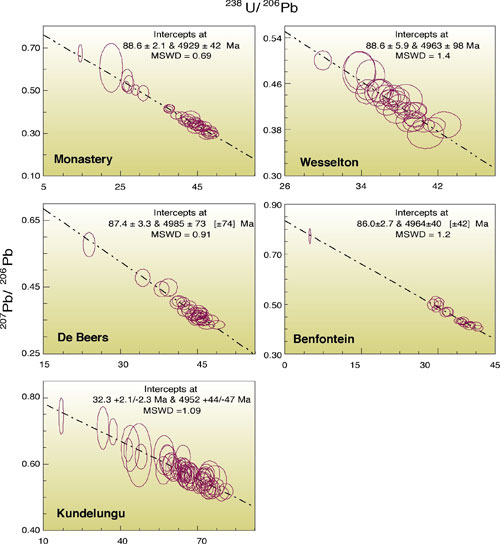 This research focussed on development of a rapid and robust method of dating kimberlites using groundmass perovskites in thin sections (GEMOC Publication #505). Perovskite is one of the late-stage minerals to crystallise from the kimberlitic magma. It is found as individual crystals or overgrowths on minerals such as ilmenite. Since it is a main carrier of U and Th in the kimberlite, it offers the possibility of U-Pb dating, and because it is not an inherited mineral it is more likely to yield the emplacement age of the kimberlite.
This research focussed on development of a rapid and robust method of dating kimberlites using groundmass perovskites in thin sections (GEMOC Publication #505). Perovskite is one of the late-stage minerals to crystallise from the kimberlitic magma. It is found as individual crystals or overgrowths on minerals such as ilmenite. Since it is a main carrier of U and Th in the kimberlite, it offers the possibility of U-Pb dating, and because it is not an inherited mineral it is more likely to yield the emplacement age of the kimberlite.
The analytical techniques used are identical to those used for LAM-ICPMS U-Pb dating of zircon. The ablation is done in He which permits efficient sample transport, signal stability and reproducibility of U/Pb fractionation. Because there is no well-established perovskite standard, we used the zircon standard (GEMOC GJ-1, age 609 Ma) commonly used for zircon U-Pb dating.
Figure 1. Inverse-concordia (Tera-Wasserburg) plots showing perovskite U-Pb analyses for several kimberlites.
Perovskite, unlike zircon, takes up significant amounts of Pb in its lattice during crystallisation, and the measured Pb-isotope composition is a mixture of this “initial Pb” and the radiogenic Pb produced by decay of U and Th. We have corrected for the initial Pb content by analysing a large number of grains, and carrying out a regression analysis in the inverse-concordia plot (Fig. 1) to determine both the composition of the initial Pb (upper intercept) and the composition of the radiogenic Pb (lower intercept; this gives the age).
The method was validated by analysis of perovskites from the De Beers, Monastery, Wesselton and Benfontein mines in the Kimberley District, South Africa, and zircons from the Monastery mine. The De Beers, Monastery and Wesselton kimberlites were previously dated respectively at 86 ± 3 Ma (K-Ar on micas), 90 ± 4 Ma (zircon U-Pb and Rb-Sr on whole-rock samples) and 90 ± 3 Ma (zircon U-Pb).
Perovskite ages for the De Beers, Monastery, Wesselton and Benfontein kimberlites are respectively 87.3 ± 3.3 Ma (n = 22; MSWD = 0.91), 88.6 ± 2.1 Ma (n = 32; MSWD = 0.69), 88.6 ± 5.9 (n = 31; MSWD = 1.4) and 86.0 ± 2.7 (n = 19; MSWD = 1.2) (Fig. 1). Zircons from the Monastery kimberlite give an age of 88.4 ± 0.9 Ma age (n = 18; MSWD = 0.76). These ages compared to those determined by different methods clearly support the robustness and accuracy of the method. This also indicates that the use of a zircon standard for U-Pb dating of perovskite gives robust results. The Kundelungu kimberlites (SE Congo) were dated at 32.3 ± 2.2 Ma (lower Oligocene), making them perhaps the world’s youngest true kimberlites.
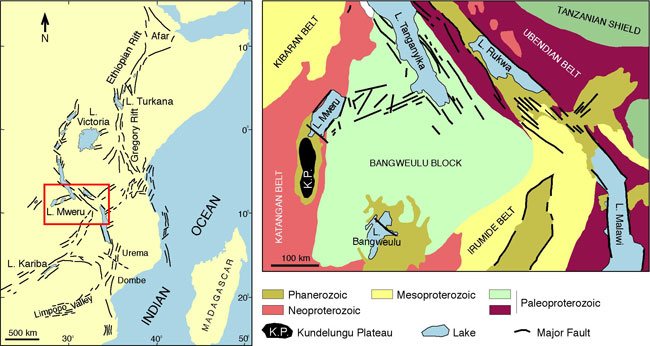
Figure 2. (a) Regional rift system in eastern Africa. Box shows area of Figure 2b. (b) Geological sketch map showing setting of the Kundelungu Plateau (KP), which is intruded by the Kundelungu kimberlites.
The 207Pb/206Pb of the initial-Pb component derived from the upper intercepts of the regression lines (see Fig. 1), 0.831 ± 0.022 for Kimberley and 0.813 ± 0.022 for Kundelungu, are similar to the values estimated for the bulk silicate Earth at around 80 Ma (0.851 ± 0.019) and 30 Ma (0.844). The value found for Group I kimberlites from Kimberley District is consistent with the average (0.80 ± 0.1) whole-rock Pb isotope composition of other Group I kimberlites in South Africa. This suggests that these kimberlites have entrained much of their lead content from the lithospheric mantle prior to crystallisation.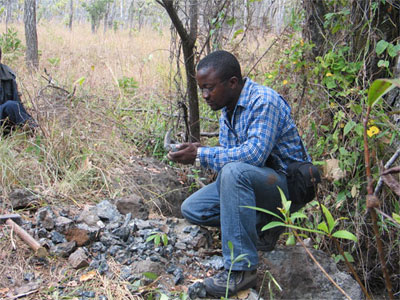
Figure 3. Jacques Batumike selecting kimberlite samples in SE Congo.
Kimberlites may also provide information on the regional tectonics at the time of their emplacement, as kimberlite magmatism is triggered by relatively weak extensional stresses affecting the lithosphere. The age distribution of the kimberlite intrusions may thus shed light on the tectonic evolution of the region. The age of the Kundelungu kimberlites corresponds to the initiation of the East African Rift, which has been dated at 43 Ma in Ethiopia, at 33-25 Ma in Kenya and Yemen and at 36 Ma in the Lake Turkana region (Fig. 2). The Kundelungu kimberlites are the youngest known in the continent. This implies the southward extension of the initial phase of the opening of the East Africa Rift. The Mweru Lake graben in the northern part of the Kundelungu Plateau (Fig. 2) is correlated with this early stage of the rift.
Contacts: Jacques Batumike, Sue O’Reilly, Bill Griffin, Elena Belousova
Funded by: iMURS, ARC-DP, MQ International Grant, EPS Postgraduate Fund
Sino-Australian connections billion years ago?
The contemporary close relationship between Australia and China can be confidently traced back to Paleozoic times with overwhelming evidence from fossil flora and fauna and paleomagnetic data. The evidence demonstrates that several major terranes of China, including the Yangtze and Cathaysian blocks in South China and the North China Craton, were connected to Australia as a part of Gondwanaland, a super-continent that broke up about 250 million years ago. However, the location of China, and especially the South China Block (SCB), relative to the other micro-continents within the Rodinia super-continent during Neoproterozoic times remains a contentious issue; several models have placed the SCB as a “missing link” between Australia and Laurentia but in different ways (see Li et al., Precambrian Research, 160, p. 179-210, 2008 for a summary). The paleomagnetic data do not provide unique information on the paleolongitude, nor are stratigraphic comparisons between relevant terranes definitive. Further independent evidence is required to constrain the models.
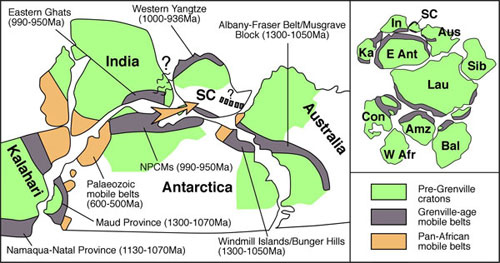
Figure 1. Reconstruction of Rodinia, with focus on the relationship between South China Block and other Rodinian terranes.
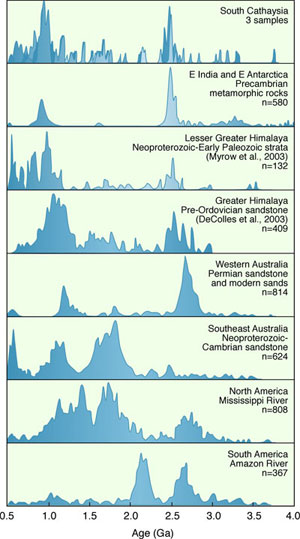
Comprehensive studies of U-Pb geochronology and Lu-Hf isotopic systematics on detrital zircons from latest-Neoproterozoic (Sinian) sedimentary rocks of the Cathaysia block in South China have been carried out using GEMOC’s laser ablation technology (GEMOC publication #518). The detrital zircons show a range of ages and compositions, with a significant Grenvillian (ca 1 Ga) population. This suggests that there was once a Grenvillian orogenic belt, probably developed on a Neoarchean basement, along or close to the southern part of the Cathaysia block.
Figure 2. Zircon 207Pb/206Pb ages for the South China Block and other relevant locations.
Minor Eo- to Meso-archean (~3.8 Ga, 3.3-3.0 Ga, ~2.5 Ga) and Mesoproterozoic (1.7 - 1.4 Ga) detrital zircon populations contained in the Sinian sediments may represent exotic input, probably derived from other continents previously linked with the South China block. U-Pb age spectra and Hf isotope compositions of the zircons indicate that they most likely came from India and East Antarctica. Comparisons with the tectono-magmatic history and compositions of crustal rocks in western Laurentia - eastern Australia and Eastern India - East Antarctica also suggest that these Chinese late Neoproterozoic sediments may have originated mainly from Eastern India and/or East Antarctica. This indicates that the South China Block was linked with the Eastern India - East Antarctica continents in the late Neoproterozoic rather than being located between the western Laurentia and eastern Australia continental blocks.
Therefore, U-Pb and Hf-isotope studies on detrital zircons provide an important independent constraint on the palaeogeography of the South China Block in the context of the breakup of Rodinia and the subsequent assembly of Gondwana in late Neoproterozoic time, and also give insights into the historical links between the South China Block and various Australian terranes.
Contacts: Sue O’Reilly, Bill Griffin, Ming Zhang, J-H. Yu (Nanjing)
Funded by: ARC Discovery, ARC International, NSF China, Nanjing University funds
10 years of MC-ICPMS: linking the crust and mantle
Gemoc introduced the multi-collector icpms to australia in 1998, adding a second instrument in 2003. As the operation of the MC-ICPMS laboratory at GEMOC enters its tenth year it is an appropriate time to review the advances this technology has brought to isotope geochemistry and geochronology. The most significant impact has been the development of high precision in situ isotope ratio measurements for a range of geologically important isotopic systems (e.g. Rb-Sr, Nd-Sm, Lu-Hf, Re-Os). The way had been paved by the coupling of the laser ablation microprobe (LAM) to the single-collector quadrupole ICPMS to provide in situ analysis of trace element patterns and isotope ratios (e.g. U-Pb dating of zircon).
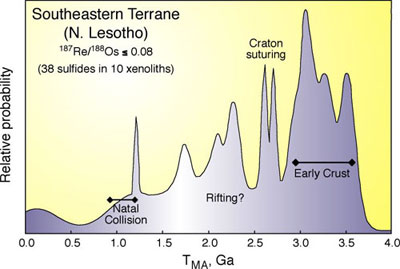 Figure 1. Re-Os model ages of sulfide grains in xenoliths from Northern Lesotho kimberlites, showing correlations with known tectonic events.
Figure 1. Re-Os model ages of sulfide grains in xenoliths from Northern Lesotho kimberlites, showing correlations with known tectonic events.
The introduction of the second generation sector-field MC-ICPMS instruments brought a number of advantages over the quadrupole ICPMS, including simultaneous detection, flat-topped peaks and greater sensitivity. All of these factors contributed to the more precise measurement of isotope ratios and made the results from the MC-ICPMS directly comparable with those obtained on the more conventional thermal ionisation mass spectrometers (TIMS). The MC-ICPMS has two great advantages over TIMS: (1) due to the high efficiency of the ICP source to ionise refractory elements, the MC-ICPMS has become the instrument of choice to investigate mass-dependent isotopic fractionation of stable isotopes of light and heavy metals (e.g. Li, Mg, Fe, Cu, Mo, Tl); (2) a LAM system can be coupled to the MC-ICPMS for in situ high-precision microanalysis of isotopic ratios.
The impact of in situ isotope ratio analysis has advanced modern geochronology beyond the acquisition of dates. Not only does the method provide rapid and precise data, but it puts these data in a microstructural framework and allows integration with datasets produced by other microanalytical techniques. The integration of these multiple sources of data gives better constrants on the origin of the sample and the processes that produced it, so that we can understand the meaning of a date in terms of geological events.
The two most significant developments in LAM-MC-ICPMS in the past decade have been the analysis of Lu-Hf isotopes in zircon and Re-Os isotopes in sulfides and PGE alloys. Zircon and the sulfide minerals are microscopic time capsules for the crust and mantle respectively, and the isotopic studies provide information about the evolution of each layer. By determining the timing of events in the crust and the underlying lithospheric mantle, linkages between crustal and mantle processes can be assessed and used to address key problems in geodynamics.

Simon Jackson, Sue O’Reilly, Bill Griffin, Norman Pearson, Ashwini Sharma and Carol Lawson at the inauguration of Australia’s first MC-ICPMS (1998); Nu-05 is still in operation (photo from archives).
The analysis of Hf isotopes in igneous zircon by LAM-MC-ICPMS provides information on the sources of the parent magmas. The analytical method was first demonstrated by Thirlwall and Walder in 1995 but was not taken up again until GEMOC developed high-precision in situ analysis in 1999 (see GEMOC publication #179). The integration of the in situ Hf-isotope data on zircons with data on their morphology and internal structure (imaged by BSE/CL), U-Pb age and trace element composition rapidly led to the establishment of TerraneChron®. TerraneChron® is GEMOC’s unique methodology for terrane evaluation and studies of crustal genesis. The combination of age, composition and sources of magma for a large number of grains is used to construct an “Event Signature” that gives a fingerprint of crustal evolution in the terrane. The TerraneChron® methodology typically is applied to zircons in drainage samples collected from a defined catchment. The use of drainage samples has many advantages for regional studies: nature has separated and concentrated a statistically more meaningful sample than is achievable by conventional single-rock sampling, thus giving a more comprehensive coverage of the rock types in the drainage region. This enables this type of remote-sensing mapping on a range of scales (10-1000 km2) and in terrains ranging from mountainous (e.g. Himalayas, Andes) to alluvial plains (e.g. Yilgarn, WA; see GEMOC publications #300, 385).
On the global scale the combinaton of Hf-isotope data and age distributions can be used to distinguish between juvenile additions to the crust and upper-crustal rocks derived by reworking of older rocks. A compilation of results shows that since the late Archean, additions of juvenile crust have been small in comparison to the volume of reworked material. These types of data clearly are going to have a large impact on ideas about the rates of growth of the continental crust through time.
A major advance in the application of Re-Os to the mantle came with the recognition that the Os budget of mantle-derived peridotites is controlled by trace sulfide phases, and that these rocks typically contain several generations of sulfide with widely differing Os contents and Re/Os. GEMOC pioneered the development of LAM-MC-ICPMS techniques for the in situ analysis of Os isotopes in individual sulfide grains and showed that different sulfide generations also have widely varying Re/Os and 187Os/188Os (see GEMOC publications #267, 290; Fig. 1). The implication is that whole-rock Os-isotope analyses of sulfide-bearing peridotites must represent mixtures of components with different ages and isotopic compositions. In such cases, the model ages of these rocks can only be regarded as minimum estimates of melt-depletion ages, and are unlikely to date any particular event (see GEMOC publication #326).
The development of these analytical techniques over recent years has made it possible to compare the large scale evolution of the crust and the history of its underlying mantle, where xenolith-bearing volcanic rocks are available. Studies linking crustal and mantle evolution in cratonic settings, young fold belts and rift zones (see Spitsbergen Research Highlight) demonstrate the potential of this approach to shed light on continental generation, modification and destruction.
Deep-seated events are commonly mirrored in the crust; Os model-age spectra from xenolith suites show age “peaks” that correspond to the ages of thermal/tectonic events in the overlying crust, suggesting strong linkages between crust and mantle (Fig. 1). Integrated studies of the timing and nature of crustal and mantle events, using these techniques, will be important for understanding the large-scale dynamics of the Earth.
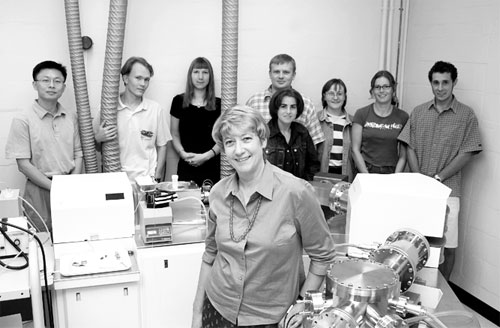
Sue O’Reilly, PhD students and overseas visitors surround Nu-05 in 2005 (photo from archives).
Contacts: Norman Pearson, Bill Griffin, Sue O’Reilly
Funded by: ARC, DEST SII, Macquarie University and Industry
How much potassium is in the Earth’s core?
The presence of potassium in the core is a vexing issue in Earth Science. The inner dynamics of our planet depend largely on how much energy is stored in its core. Crystallisation of the inner core, generation of the magnetic field and convection in the outer core and mantle are intimately linked to the amount of heat present in the core. Accurately describing the heat budget of the core depends on an accurate determination of the concentration of heat-producing elements. A significant amount of these elements would permit much slower rates of cooling and inner-core growth.

Figure 1. Partition coefficients for potassium (DK) shown as a function of temperature. In white, data and predictions from the literature. Our new data indicate that there are no significant pressure and temperature effects on K partitioning contrary to recent predictions.
The presence of potassium (K) as a significant radioactive element in the core was suggested over three decades ago. However, despite numerous theoretical and experimental studies, it is still not clear whether K actually is present in the core. In particular, previous experimental studies on K partitioning between metallic and silicate liquids have yielded contradictory results concerning the fate of K during the favoured scenario of core formation in a deep silicate-magma ocean. Experimental and analytical artefacts, large extrapolation to appropriate conditions of high pressure and high temperature and the use of oversimplified chemical compositions in these studies have cast doubt on previous experimental results.
Research at Macquarie University and the Carnegie Institution of Washington (see GEMOC publication #455) has provided new experimental data for the partitioning of potassium in a chemical composition relevant to models of Earth’s differentiation. Experiments were carried out at 2200 °C and 7.7 GPa to equilibrate a silicate melt of primitive mantle composition (fertile peridotite) with a variety of Fe–Ni–S–C–O molten alloys. As shown in Figure 1, these new data reveal a negligible effect of pressure and temperature on the partition coefficient (DK, the weight ratio of K content in the alloy over K content in the silicate), at least over the P-T conditions of the study. These observations contrast with recent predictions based on published data, which suggest a systematic increase of K solubility in the alloy with temperature (Fig. 1). Our experimental work also indicates that the K solubility is not directly affected by the S and C contents of the alloy. However, there may be an increase in the K partition coefficient with increasing O content in the molten alloy (Fig. 2). Overall, these new results, which are appropriate for modelling core formation in a shallow magma ocean, suggest that appreciable amounts of K are unlikely to be sequestered into Earth’s core during a magma-ocean event unless oxygen is a major component in the light element budget of the core.

Figure 2. Potassium partition coefficient plotted as a function of oxygen partition coefficient. The observed correlation suggests that O may have a significant effect on K solubility in molten alloy.
Contact: Alexandre Corgne
Funded by: ARC, Carnegie Institution of Washington, NASA and NSF
Heat sources in mantle plumes
Melting anomalies in the earth’s upper mantle have often been attributed to the presence of mantle plumes that may originate in the lower mantle, possibly from the core-mantle boundary. Globally, mantle plumes exhibit a large range in buoyancy flux that is proportional to their temperature and volume. Plumes with higher buoyancy fluxes should have higher temperatures and experience higher degrees of partial melting. Excess heat in mantle plumes could reflect either a) an enrichment of the heat producing elements (HPE: U, Th, K) in their mantle source leading to an increase of heat production by radioactive decay or b) advective or conductive heat transport across the core-mantle boundary. The advective transport of heat may result in a physical contribution of material from the core to the lower mantle. A contribution of material from the core should result in higher Fe concentrations and coupled enrichments in 186Os/188Os and 187Os/188Os relative to the upper mantle (Fig. 1). If plumes are generated purely by differences in their chemistry (e.g. by varying HPE content), then increased abundances of U, Th, and K would lead to increased temperatures and, in turn, to higher buoyancy fluxes (Fig. 1).
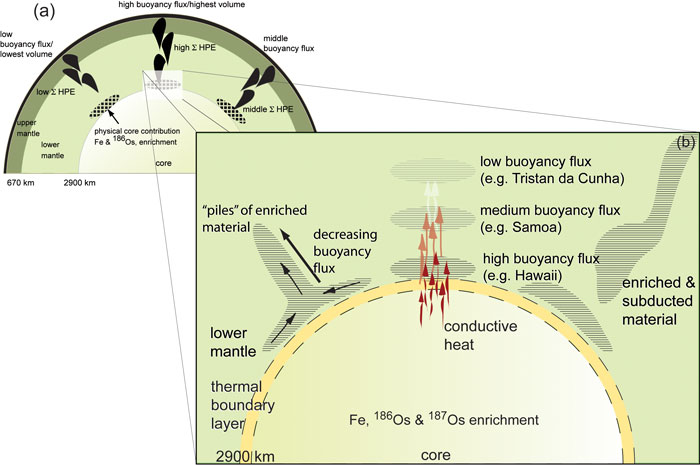
Figure 1. Model of possible effects leading to the formation and rise of mantle plumes. A physical, i.e. material, and hence, heat contribution from the core would be reflected in increased Fe, 186Os and 187Os, whereas a formation of mantle plumes as a result of increased concentrations of U, Th and K has been ruled out by a lack of correlation between HPE and buoyancy flux. It is most likely conductive heat transport from the core towards the mantle leads to the rise of enriched material. It has to be taken into consideration that the core-mantle boundary topography is irregular (Garcia and Souriau, Physics of The Earth and Planetary Interiors, 2000), but we suggest that the relative distance to the outermost core is the main factor of the conductive heat contribution to triggering plume generation. The formation of “piles” of enriched material may be consistent with our model, i.e. the relative distance to the core-mantle boundary may control the plume’s excess heat largely independently of the shape of the enriched material along the core-mantle boundary. Not to scale.
Geophysical and dynamic modelling indicate that at least the Afar, Easter, Hawaii, Louisville and Samoa plumes may all originate at the core-mantle boundary. These plumes encompass the whole range of known buoyancy fluxes from 0.9 Mgs-1 (Afar) to 6.5 Mgs-1 (Hawaii) providing evidence that the buoyancy flux is largely independent of other geophysical parameters.
Major element, trace element and radiogenic isotope data for all available intraplate volcanic settings with published buoyancy fluxes (Sleep, JGR, 1990) were used in our analyses. We used the compiled GEOROC database (http://georoc.mpch-mainz.gwdg.de/georoc/) for all of our geochemical data except from the Azores. Data from the Azores were taken from a separate existing dataset. Only alkaline samples (>2 wt.% K2O+Na2O at 45 wt.% SiO2 with >5 wt.% and <20 wt.% MgO were taken into consideration to avoid extended assimilation and fractional crystallisation effects. To minimise possible effects of mixing between depleted and enriched compositions, we focused on alkaline basalts rather than tholeiites. All alkaline data were fractionation-corrected to 10 wt.% MgO using a logarithmic fit.
|
Figure 2. Average fractionation corrected (to 10 wt.% MgO) K, Th and U concentrations [ppm] versus buoyancy flux in Mgs-1 of Atlantic, Pacific and Indian plumes and from the Afar plume. Error bars represent compositional range of each plume. Buoyancy flux as given in Sleep (JGR, 1990). |
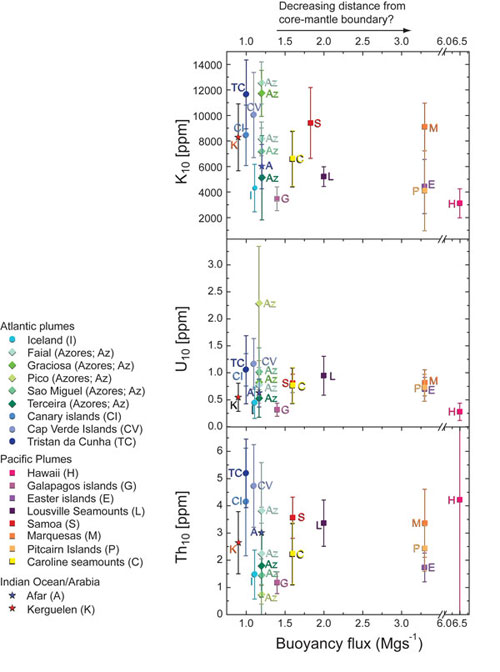 |
We find that the fractionation-corrected heat producing elements (U, Th and K) and Fe are not correlated with buoyancy flux/upwelling rate (Fig. 2). This provides evidence that the excess temperatures in plumes require additional heat contribution rather than a chemical source heterogeneity. The lack of correlation between buoyancy flux and the possible core contributing tracer Fe tentatively suggests that the heat contributed may not be related to advective heat flow from the core, but may be a result of conductive heat transport from the core into the lower mantle.
The formation of thermochemical piles (Fig. 1) as proposed by geodynamic models is consistent with a heterogeneous distribution of enriched material along the core-mantle boundary and would also help to explain differences in buoyancy fluxes, where smaller piles (e.g. Azores, Canary islands) will have less internal heat, slightly higher viscosity, and hence less conductive heat transport, leading to a lower buoyancy flux than larger piles with more internal heat production, lower viscosity and higher heat contribution from the core (e.g. Hawaii).
Contact: Christoph Beier
Funded by: Humboldt Foundation, Macquarie University
Flawed crystals control Earth’s properties
|
Figure 1. Scanning electron microscope images of synthetic spinel (light grey), forsterite (dark grey) and glass from experiments conducted in the High-Pressure laboratory. |
No matter how flawless they appear to the naked eye, natural crystals are never composed of atoms located in their perfect atomic arrangement. Without exception, crystals contain foreign atoms, or positions within the lattice that deviate from perfect crystal chemistry. Such imperfections are called ‘defects’, and there are several different types. Point defects exist when an atom normally present in the regular geometric atomic arrangement of a crystal is missing, or is present in an irregular place. Lattice vacancies, interstitial atoms and substitutional impurities are all types of point defect. The particular defect species present in a crystal is dependant on different thermodynamic parameters. Although these microscopic imperfections occur on a tremendously minute scale, their influence on the chemical, physical properties of the entire Earth is profound. Adding impurity elements – a process ubiquitous in natural systems - is a common way of introducing point defects into natural crystals. Amongst other things defects control atomic diffusion - a process by which individual atoms move through media via vacancies, interstitial impurity atoms or different interstitial positions. Understanding point defects in natural samples helps understand the accretion and subsequent evolution of our planet, and represents a fundamental area of research in the experimental petrology laboratories at Macquarie University. Through the synthesis of Earth-forming materials (Fig. 1), studies conducted in our labs have shown that, at concentrations relevant to many natural samples, Sc3+ and most other trivalent cations substitute into olivine by replacing Mg2+, and charge balance is maintained by the creation of metal vacancies. At slightly higher concentrations, trivalent cations are incorporated via the development of Sc3+-Li1+ centres replacing Mg2+-Mg2+. Experiments aimed at understanding the defect chemistry of Li in natural samples show that Li concentrations are in excess of those which can be accounted for through the development of trivalent-Li centres. Furthermore, the results of experiments conducted at variable oxygen fugacity (fO2) indicate that the dominant charge compensation mechanism in this regime is most likely via contemporaneous incorporation of Li on tetrahedral sites (Li'Mg) and interstitially. Since olivine is the dominant host for Li in the upper mantle and isotopic fractionation is strongly dependent on crystal chemistry, these results have important implications for understanding the isotopic composition of Li in natural rocks. Additional experiments have shown that the concentration of water in mantle olivine is strongly influenced by fO2 and silica activity (aSiO2). Our results led us to propose a reaction for the formation of protonated Fe3+ centres in olivine and allowed us to interpret and reconcile the results of several previous and apparently contradictory experimental studies. From a consideration of point defect equilibria we arrived at a mechanism for the incorporation of hydroxyl in olivine in a way that is appropriate for the actual range of conditions expected in the upper mantle of the Earth (see GEMOC publications #474, 478, 480, 510). |
Contact: Kevin Grant
Funded by: Macquarie University and ARC Discovery

 GEMOC ARC National Key Centre
GEMOC ARC National Key Centre